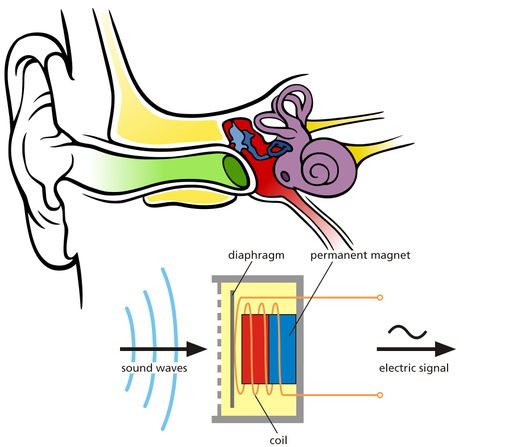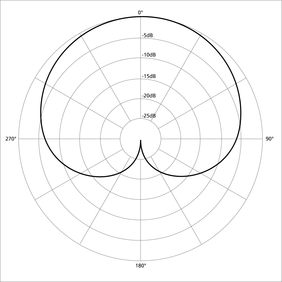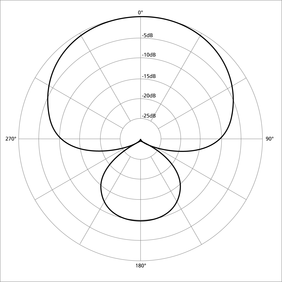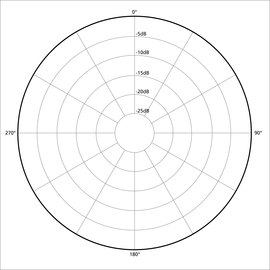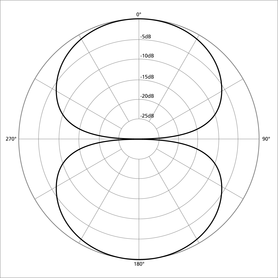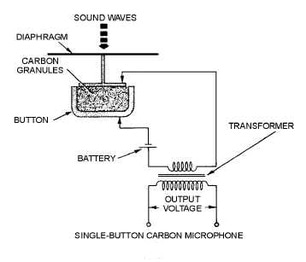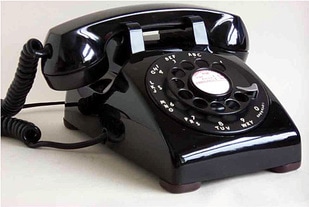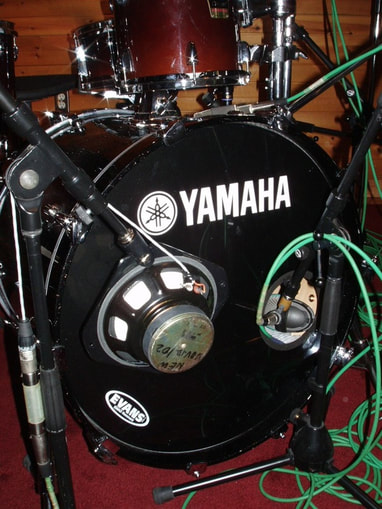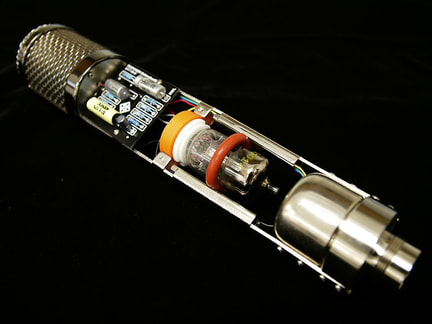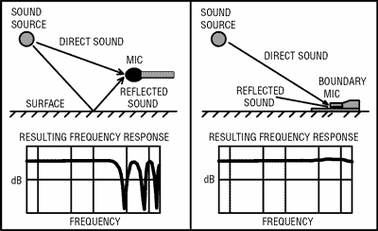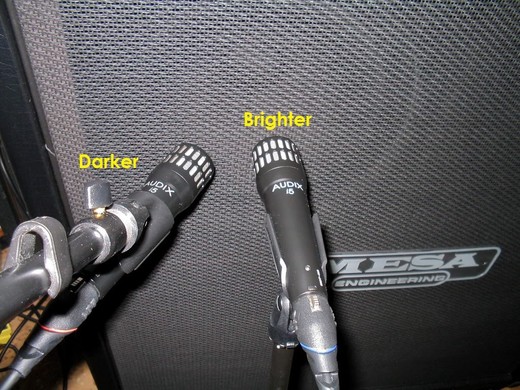MICROPHONE TYPES & TECHNOLOGY
The microphone is nothing more than an attempt to simulate the human ear. There is no way one could ever design or build something as magnificent as the human ear, but manufacturers have tried; it's called a microphone. Because one cannot hook up a wire to the eardrum and send it to a recorder or a mixing console, there is a need for something to "hear" sounds in which to amplify them and/or record them. The object most basically comparable to the human eardrum is the microphone diaphragm. Sound causes the eardrum to vibrate, and the brain converts these vibrations to discernible signals. Well, a microphone is the essence of the saying: "Imitation is the sincerest form of flattery"; the microphone works exactly the same way. The incoming sound wave produces a vibration on the diaphragm, and this vibration is then converted to a signal.
Manufacturers make various makes and models of microphones for many different purposes; knowing which specific microphone is best to place on a particular instrument comes through experience. A good sound engineer should be able to recognize just about any microphone and be able to explain what it is best used for. Again, this only comes through experience.
This following list provides a quick and easy resource for determining which microphone to use for what job and how to get the best use from it.
Let's get started – Here is a list of different microphones, described in the simplest of terms for quick access; the list begins with basic characteristics of microphones then moves on from there. We will discuss pickup patterns first - also known as lobes (the place(s) where the microphone picks up sound best).
Microphone Patterns
Microphones pick up sounds in different ways. Some pick up sound just from the front, and others from both the front and back. Some only pick up sounds in a very narrow field, and yet others pick up sounds from all directions. These different pickup patterns, where different microphones pick up certain sounds the best, are described as lobes. Knowing the microphone’s intended use and knowing the specific pickup patterns help one to choose the microphone best suited to the task.
For example: If you are on a very loud stage, you could select a pattern that will reject sounds from everywhere but the front of the microphone.
Here are the most common patterns in microphones:
For example: If you are on a very loud stage, you could select a pattern that will reject sounds from everywhere but the front of the microphone.
Here are the most common patterns in microphones:
cardioid

The SM-58 by Shure is one of the best-known cardioid microphones on the planet. A cardioid microphone has only one lobe, meaning that it only picks up sound in the front of the microphone. In practical terms, this means that if you have a stage monitor firing at you from the side and you are getting feedback, you can move that monitor to the rear of the microphone, where the singer is staring right at it. That location, where the sound is least "picked up" on a microphone, is called the Null.
Placing a stage monitor where it is firing at the Null is the best place with this type of microphone, because there is the least amount of stage "bleed" from it, making it less likely to feed back. I was at a concert a while back assisting a young engineer, and the lead vocalist's microphone had some really rough feedback going on. The engineer reached for the EQ right away. I stopped him and said, "You don't have to do that...watch this." I went and moved the stage monitor to where it was firing at the Null, and the feedback was gone for good. Placement is a better fix then processing because if you have to start cutting frequencies, the original sound of the instrument or vocal with also have that cut as well! With correct monitor placement, there's no tradeoff, but there is with EQ'ing just to fix feedback. Sometimes you have to still EQ it if you've exhausted your other options, but try moving it first.
Placing a stage monitor where it is firing at the Null is the best place with this type of microphone, because there is the least amount of stage "bleed" from it, making it less likely to feed back. I was at a concert a while back assisting a young engineer, and the lead vocalist's microphone had some really rough feedback going on. The engineer reached for the EQ right away. I stopped him and said, "You don't have to do that...watch this." I went and moved the stage monitor to where it was firing at the Null, and the feedback was gone for good. Placement is a better fix then processing because if you have to start cutting frequencies, the original sound of the instrument or vocal with also have that cut as well! With correct monitor placement, there's no tradeoff, but there is with EQ'ing just to fix feedback. Sometimes you have to still EQ it if you've exhausted your other options, but try moving it first.
Super cardioid

Some dynamic microphones are super-cardioid microphones. This means that its pattern has a narrower field in the front in which it picks up sound but is also able to pick up a little in the back as well. Notice that this microphone pattern has 2 nulls. This means that if a vocalist were singing through a super-cardioid microphone, the best place for a monitor would be at approximately a 35° angle. Another pattern similar to the super-cardioid, but on "steroids," is the hyper-cardioid pattern. This is even more narrow of a pickup pattern on the front of the microphone, but also has a larger pickup pattern in the rear of the microphone as well.
omni

Omni microphones can pick up sounds from all directions. An omni microphone is typically used if you'd like to pickup up more of the room. This would be the case in a classical music hall, or if you want to do the old school gather around one microphone jazz or bluegrass set. Omni microphones can also be utilized for a more traditional setting where you may have just a grand piano. At my church, we utilize 2 omni microphones in stereo as our ambiance microphones for our in-ear monitoring system. This helps bring in more of the room so that what you are hearing is more natural, and doesn't sound as if you are in a vacuum.
Bi-Directional / figure 8

A figure-8 microphone can pick up sounds equally from both the front and back of the microphone. As the diagram shows, this particular pickup pattern has 2 lobes and 2 nulls. Ribbon microphones are the most common microphones to have this type of pickup pattern.
There are some large-diaphragm microphones that actually give options for what pattern to use. The world-famous AKG 414 is an example. With this microphone, you can select omni, cardioid, super-cardioid, or figure 8. Because of this feature, the 414 is extremely versatile.
Hemispherical / half-omni
This type of pattern belongs only to boundary/PZM microphones. These microphones excel in applications where you need a great sounding low profile solution - like podiums, lecterns, piano lids, etc. Most of the time, these microphones have a hotter signal because the microphone’s location (on a flat surface) is at a soundwave's pressure maximum, which rids the signal of any comb filtering effects. I've seen these microphones being used in plays and skits, mounted to stage props and such for actor dialog. This is ideal for churches that may not be able to afford for each actor to have a lapel microphone.
Microphone Types
Carbon Microphones
The carbon microphone is credited in modern times as the first microphone developed. Though Thomas Edison was awarded a patent for it, it was this dude who actually invented it:
A bunch of his bros were like, "Dude, you could make some money on this deal," but Mr. Hughes wanted to give it to the world as a gift. That's when things got really awesome because, then, back in the day we had this fella here:
Dynamic Microphones
A dynamic microphone is typically a microphone without any preamp built into its housing (one exception is Blue's Kickball). It is generally, though not an absolute rule, preferred over condenser microphones for very loud sound sources. Dynamic microphones are chosen for live use on a more regular basis than their condenser microphone counterparts. Most dynamic microphones have a cardioid pattern (see above).
A dynamic microphone is typically a microphone without any preamp built into its housing (one exception is Blue's Kickball). It is generally, though not an absolute rule, preferred over condenser microphones for very loud sound sources. Dynamic microphones are chosen for live use on a more regular basis than their condenser microphone counterparts. Most dynamic microphones have a cardioid pattern (see above).
Even though the above is a cutaway picture of a speaker, a dynamic microphone works the same way, but in reverse. That's why this works:

So basically this is a diaphragm that moves when sound hits it. The diaphragm is connected to coil that surrounds a magnet. As the diaphragm moves back and forth, the coil moves over the magnet. This generates a signal that is usually sent to a transformer to convert it to useable impedance; then the signal is amplified.
The benefit of dynamic microphones is that they are very durable and can take a lot of decibels (some immeasurable). They are also less sensitive to stage noise and are super resilient to humidity changes and other abuse. I have seen old SM-58s that appeared as if someone had attached it to the end of a Roto-Rooter, run over it with a belt sander, and used it as a makeup applicator, and it still sounded fine.
The benefit of dynamic microphones is that they are very durable and can take a lot of decibels (some immeasurable). They are also less sensitive to stage noise and are super resilient to humidity changes and other abuse. I have seen old SM-58s that appeared as if someone had attached it to the end of a Roto-Rooter, run over it with a belt sander, and used it as a makeup applicator, and it still sounded fine.
In recent times, the condenser microphone has been the go-to for many instruments, but I have found that dynamic microphones are more suited for a number of tasks. For instance, a dynamic microphone is typically a much better choice for violin (ribbon is cool, too) than a condenser.
Or take a dynamic microphone like the Shure SM-7(b); this microphone is just killer beans on so many instruments—vocals, electric guitar amps, strings, etc.
A dynamic microphone makes a killer hi-hat mic, too, which makes perfect sense! Match the microphone to the source. Why is it that a condenser has to be the choice for hats? Makes no sense to me. There is less bleed from the snare with a dynamic, and you tame some high-end at the same time! Listen to the softness of Anika's hi-hats in this track. Obviously there's some processing going on as well, but notice how her hats don't sound "spitty":
|
Condenser Microphones
A condenser microphone is a microphone that has a more sensitive diaphragm than a dynamic microphone; it also has preamp circuitry built into its housing. This circuitry requires an outside power source. On a few of these types of microphones, this power is supplied by a battery, but, on most condenser microphones, the power is supplied by the mixing console or a separate microphone preamp. This power is called Phantom Power. It is usually rated at +48 volts DC. Some high-end condenser microphones have their own external power supply for high-voltage applications. Some condenser microphones have a switchable pattern feature. This means that you can select which pattern for your microphone to use. If you want your microphone to only pick up sound in the front, switch it to cardioid. If you want it to pick up sound from all directions, switch it to omni. If you would like for it to pick up sounds from both the front and rear of the microphone, but not on the sides, select Figure 8 (aka bi-directional). |
|
Check out this video on how Neumann makes their U87ai condenser microphone to get an idea of how a condenser works and "how it's made."
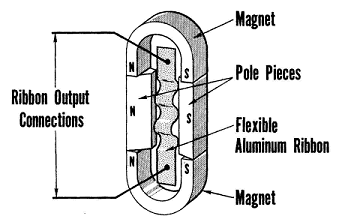
Ribbon Microphones
Ribbon microphones have been around for a very long time (invented around 1922 by a dude named Walter Schottky, with help from another dude named Erwin Gerlach). A ribbon mic is a microphone in which a thin corrugated strip of aluminum suspended between two poles of a magnet serves as a diaphragm and voice coil. The velocity of sound particles moves the aluminum ribbon within a magnetic field. This in turn generates a small AC current that is proportional to the movement of the ribbon. This signal is then sent to a step-up transformer from the contacts located on both the top and bottom sides of the ribbon, where it converts the signal to a useable level for a microphone preamp. These microphones pick up sound in the Bi-Directional (Figure-8) polar pattern. Ribbon microphones produce a warmer sound than condenser microphones. The following picture shows a typical configuration of what a ribbon microphone looks like on the inside:
Ribbon microphones have been around for a very long time (invented around 1922 by a dude named Walter Schottky, with help from another dude named Erwin Gerlach). A ribbon mic is a microphone in which a thin corrugated strip of aluminum suspended between two poles of a magnet serves as a diaphragm and voice coil. The velocity of sound particles moves the aluminum ribbon within a magnetic field. This in turn generates a small AC current that is proportional to the movement of the ribbon. This signal is then sent to a step-up transformer from the contacts located on both the top and bottom sides of the ribbon, where it converts the signal to a useable level for a microphone preamp. These microphones pick up sound in the Bi-Directional (Figure-8) polar pattern. Ribbon microphones produce a warmer sound than condenser microphones. The following picture shows a typical configuration of what a ribbon microphone looks like on the inside:
Notice how there are two magnets on each side of the "crinkled" ribbon element in this classic RCA ribbon mic. Below this ribbon element, there is a transformer that increases/converts the signal to a useable impedance level before it is sent to the mixing console. This is essentially how most ribbons are made. There is a variety of shapes and sizes according to the manufacturer, but in each it is the same essential technology that gives the ribbon mic its warm sound. An example of a very modern ribbon microphone would be the Shure KSM353, as seen above.
As stated before, ribbon microphones are typically darker and/or warmer sounding. This is in part due to how the ribbon itself is built and the very nature of its technology. The other reason is that ribbon microphones (or at least the classic-designed) feature transformers as part of how they work, thus "mangling" the sound they pick up in a pleasant way.
Please note: Ribbon mics are a lot more fragile and can be damaged by loud sources with heavy wind velocity (like a kick drum). A dynamic microphone can be placed in front of a kick drum that is putting out 140 db without damage. If you tried that with most ribbons, they could be ruined. I also really need to mention that you need to be very careful when using a ribbon microphone because most of them cannot take phantom power. Phantom power will usually melt the ribbon of a ribbon microphone, thus ruining the mic. Royer ribbon microphones are an exception to this.
Please note: Ribbon mics are a lot more fragile and can be damaged by loud sources with heavy wind velocity (like a kick drum). A dynamic microphone can be placed in front of a kick drum that is putting out 140 db without damage. If you tried that with most ribbons, they could be ruined. I also really need to mention that you need to be very careful when using a ribbon microphone because most of them cannot take phantom power. Phantom power will usually melt the ribbon of a ribbon microphone, thus ruining the mic. Royer ribbon microphones are an exception to this.
Boundary Microphones
Boundary microphones have Half Omni-Directional pickup patterns. A boundary microphone is usually mounted on a flat-hard surface such as a table, or underneath the bottom of a piano lid, or on a lectern. It can be great for stage use for dramas and skits or as a microphone on a table for TV interviews. They are low profile, and are typically very sensitive with a condenser element mounted on a horizontal plane. A boundary microphone looks like this:
Boundary microphones have Half Omni-Directional pickup patterns. A boundary microphone is usually mounted on a flat-hard surface such as a table, or underneath the bottom of a piano lid, or on a lectern. It can be great for stage use for dramas and skits or as a microphone on a table for TV interviews. They are low profile, and are typically very sensitive with a condenser element mounted on a horizontal plane. A boundary microphone looks like this:
Cool Tip Alert: You can make a boundary microphone just by attaching an omni-directional condenser mic to a flat piece of plexiglass.
Yes, A Microphone Has A Voice
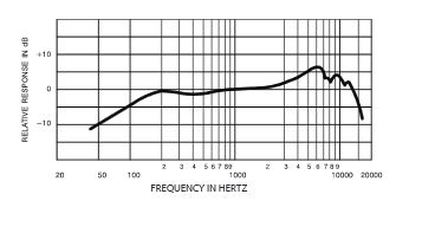 This is the frequency response of an SM-57. Notice the boost in the upper mid-range, and the sharp drop off in the bass frequencies starting at 200 hz.
This is the frequency response of an SM-57. Notice the boost in the upper mid-range, and the sharp drop off in the bass frequencies starting at 200 hz.
Microphone Types and Their Voice
As already covered, the type of microphone can really affect its "voice" (check out our Voicing Concept page for an in-depth description of this). Condensers are typically more sensitive and brighter with an extended frequency range; dynamic mics can take a lot more volume and reject extraneous noises better than condensers. Ribbon microphones are usually warmer/darker sounding. Most ribbons feature figure 8 patterns, picking up sounds from both sides of the microphone. This is all-important in choosing the right microphone for the source you are miking. If you have a very bright violin, it may not be the best idea to put a condenser microphone on it; a ribbon or dynamic microphone may be better suited to the task. If you want a flatter response from a dynamic, and not have the upper-midrange "hump" of a 57, the Stedman n90 may be the best choice. If you want something darker, the AEA 44 ribbon could even be better.
Diaphragm Size
A small diaphragm condenser (SDC), by the nature of its build, will be more detailed than a large diaphragm condenser (LDC). That is because the diaphragm is smaller in an SDC. When a sound hits the diaphragm of an SDC, its diaphragm will return to "point zero" more quickly than would that of a large diaphragm condenser.
Frequency Response
Each microphone has a character or personality to its sound. Simply stated, frequency response is one of the determining factors in how bright or how dark a microphone will sound. This is important to understand because, if a person with a really bright vocal uses a bright sounding microphone, there is bound to be an even brighter sound. Do a web search for the frequency response of any model of microphone; from there you will get a rough estimate of what the microphone might sound like. Note: Don't go crazy with this stuff, Ha! I just want to make you aware of it so that you will have a better general understanding of how microphones work and how each microphone has a "voice." The best way to REALLY determine how a microphone will sound on a source is to listen to it! After doing this stuff for a while, you will be able to know what microphone you need for what instrument.
Transient Response
This is the speed at which a microphone can respond to rapidly changing sound waves. The mass of a microphone's diaphragm will directly affect its transient response. A small diaphragm condenser's (SDC) diaphragm has much less mass than, say, a dynamic microphone. An SDC will have a faster transient response than a dynamic. In the real world, this means that a SDC will have a more detailed sound than a dynamic microphone. This can be a good thing or a bad thing depending on the instrument. Just because a mic has a faster transient response doesn't necessarily mean it's better for an instrument than one with a slower transient response. Sometimes having a slower transient response will help the tone of an instrument. Violins are a good example of this: sometimes a small diaphragm condenser can pick up too much detail in the stridency of bowed strings whereas a dynamic microphone will "smear" the image in a good way.
Transformers (More Than Meets The Eye)
Transformers are used primarily for changing the impedance of microphones to a useable level for most microphone preamps. Transformers can have a huge effect on the voicing of some of these microphones, like on ribbon mics. A few companies offer transformers for upgrading more cheaply constructed ribbon microphones; the majority of these users have reported a big difference in the overall quality of tone just by switching the transformer. The most well-respected companies that manufacture transformers are Lundahl, Jensen, Sowder, and Edcor. A while back there was a tutorial on making a Shure SM-57 sound more like a Shure SM-7 just by removing the transformer. Just keep in mind that these types of things are totally subjective, and sometimes they are not necessarily "better," just different.
Proximity Effect
The closer a microphone gets to a sound source, the more pronounced the lower frequencies will be. This is especially true of ribbon and cardioid microphones. This is important because you can change the tone of an instrument by just moving the microphone closer or further away. The only microphone type in which this is not the case is the omni. In the following graph, a famous cardioid is tested to see what effects proximity will have on its sound. As you can see, the closer a source comes to the microphone, the more low-end the frequency response graph shows.
As already covered, the type of microphone can really affect its "voice" (check out our Voicing Concept page for an in-depth description of this). Condensers are typically more sensitive and brighter with an extended frequency range; dynamic mics can take a lot more volume and reject extraneous noises better than condensers. Ribbon microphones are usually warmer/darker sounding. Most ribbons feature figure 8 patterns, picking up sounds from both sides of the microphone. This is all-important in choosing the right microphone for the source you are miking. If you have a very bright violin, it may not be the best idea to put a condenser microphone on it; a ribbon or dynamic microphone may be better suited to the task. If you want a flatter response from a dynamic, and not have the upper-midrange "hump" of a 57, the Stedman n90 may be the best choice. If you want something darker, the AEA 44 ribbon could even be better.
Diaphragm Size
A small diaphragm condenser (SDC), by the nature of its build, will be more detailed than a large diaphragm condenser (LDC). That is because the diaphragm is smaller in an SDC. When a sound hits the diaphragm of an SDC, its diaphragm will return to "point zero" more quickly than would that of a large diaphragm condenser.
Frequency Response
Each microphone has a character or personality to its sound. Simply stated, frequency response is one of the determining factors in how bright or how dark a microphone will sound. This is important to understand because, if a person with a really bright vocal uses a bright sounding microphone, there is bound to be an even brighter sound. Do a web search for the frequency response of any model of microphone; from there you will get a rough estimate of what the microphone might sound like. Note: Don't go crazy with this stuff, Ha! I just want to make you aware of it so that you will have a better general understanding of how microphones work and how each microphone has a "voice." The best way to REALLY determine how a microphone will sound on a source is to listen to it! After doing this stuff for a while, you will be able to know what microphone you need for what instrument.
Transient Response
This is the speed at which a microphone can respond to rapidly changing sound waves. The mass of a microphone's diaphragm will directly affect its transient response. A small diaphragm condenser's (SDC) diaphragm has much less mass than, say, a dynamic microphone. An SDC will have a faster transient response than a dynamic. In the real world, this means that a SDC will have a more detailed sound than a dynamic microphone. This can be a good thing or a bad thing depending on the instrument. Just because a mic has a faster transient response doesn't necessarily mean it's better for an instrument than one with a slower transient response. Sometimes having a slower transient response will help the tone of an instrument. Violins are a good example of this: sometimes a small diaphragm condenser can pick up too much detail in the stridency of bowed strings whereas a dynamic microphone will "smear" the image in a good way.
Transformers (More Than Meets The Eye)
Transformers are used primarily for changing the impedance of microphones to a useable level for most microphone preamps. Transformers can have a huge effect on the voicing of some of these microphones, like on ribbon mics. A few companies offer transformers for upgrading more cheaply constructed ribbon microphones; the majority of these users have reported a big difference in the overall quality of tone just by switching the transformer. The most well-respected companies that manufacture transformers are Lundahl, Jensen, Sowder, and Edcor. A while back there was a tutorial on making a Shure SM-57 sound more like a Shure SM-7 just by removing the transformer. Just keep in mind that these types of things are totally subjective, and sometimes they are not necessarily "better," just different.
Proximity Effect
The closer a microphone gets to a sound source, the more pronounced the lower frequencies will be. This is especially true of ribbon and cardioid microphones. This is important because you can change the tone of an instrument by just moving the microphone closer or further away. The only microphone type in which this is not the case is the omni. In the following graph, a famous cardioid is tested to see what effects proximity will have on its sound. As you can see, the closer a source comes to the microphone, the more low-end the frequency response graph shows.
On-Axis vs. Off-Axis Response
The more angled a unidirectional microphone is from a sound source, the darker the sound. This is important to consider because it allows you to "voice" the source according to what you need in a full band context.
This works with just about any type of instrument or amplifier.
The Room
One of the biggest factors affecting how a microphone sounds is the room! Say what? Yes, that's right. Think of it as you would your own ears: would the sound of an acoustic guitar sound totally different in a closet full of clothes versus a concert hall? Of course! The same holds true with microphones. The overhead microphones of a drum set will sound totally different in a large room with tall ceilings versus a drum booth.

